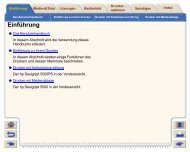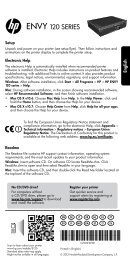HP Officejet 4500 (G510) - FTP Directory Listing - Hewlett Packard
HP Officejet 4500 (G510) - FTP Directory Listing - Hewlett Packard
HP Officejet 4500 (G510) - FTP Directory Listing - Hewlett Packard
You also want an ePaper? Increase the reach of your titles
YUMPU automatically turns print PDFs into web optimized ePapers that Google loves.
Appendix D<br />
There are two communication mode options:<br />
• Ad hoc: On an ad hoc network, the device is set to ad hoc communication mode and<br />
communicates directly with other wireless devices without the use of a WAP.<br />
All devices on the ad hoc network must:<br />
◦ Be 802.11 compatible<br />
◦ Have ad hoc as the communication mode<br />
◦ Have the same network name (SSID)<br />
◦ Be on the same subnet and same channel<br />
◦ Have the same 802.11 security settings<br />
• Infrastructure (recommended): On an infrastructure network, the device is set to infrastructure<br />
communication mode and communicates with other devices on the network, whether the devices<br />
are wired or wireless, through a WAP. WAPs commonly act as routers or gateways on small<br />
networks.<br />
Security settings<br />
NOTE: For more information on wireless security, visit www.weca.net/opensection/pdf/<br />
whitepaper_wi-fi_security4-29-03.pdf.<br />
• Network authentication: The device's factory default setting is 'Open,' which does not require<br />
security for authorization or encryption. The other possible values are 'OpenThenShared,'<br />
'Shared,' and 'WPA-PSK' (Wi-Fi ® Protected Access Pre-Shared Key).<br />
WPA increases the level of over-the-air data protection and access control on existing and future<br />
Wi-Fi networks. It addresses all known weaknesses of WEP, the original native security<br />
mechanism in the 802.11 standard.<br />
WPA2 is the second generation of WPA security; it provides enterprise and consumer Wi-Fi<br />
users with a high level of assurance that only authorized users can access their wireless<br />
networks.<br />
• Data encryption:<br />
◦ Wired Equivalent Privacy (WEP) provides security by encrypting data sent over radio waves<br />
from one wireless device to another wireless device. Devices on a WEP-enabled network<br />
use WEP keys to encode data. If your network uses WEP, you must know the WEP key(s)<br />
it uses.<br />
◦ WPA uses the Temporal Key Integrity Protocol (TKIP) for encryption and employs 802.1X<br />
authentication with one of the standard Extensible Authentication Protocol (EAP) types<br />
available today.<br />
◦ WPA2 provides a new encryption scheme, the Advanced Encryption Standard (AES). AES<br />
is defined in counter cipher-block chaining mode (CCM) and supports the Independent<br />
Basic Service Set (IBSS) to enable security between client workstations operating in ad hoc<br />
mode.<br />
To set up wireless communication using the device control panel with wireless setup<br />
wizard<br />
The Wireless Setup Wizard provides an easy way to set up and manage a wireless connection to<br />
your device.<br />
NOTE: To use this method, you must have a wireless network set up and running.<br />
1. Set up the device hardware (see the getting started guide or the setup poster that came with<br />
your device).<br />
2. On the device control panel, press the Setup button.<br />
3. Press an arrow button to move to Wireless Menu, and then press OK.<br />
4. Press an arrow button to move to Setup Wizard, and then press OK.<br />
5. Follow the display instructions to complete the setup.<br />
200 Network setup (some models only)

















